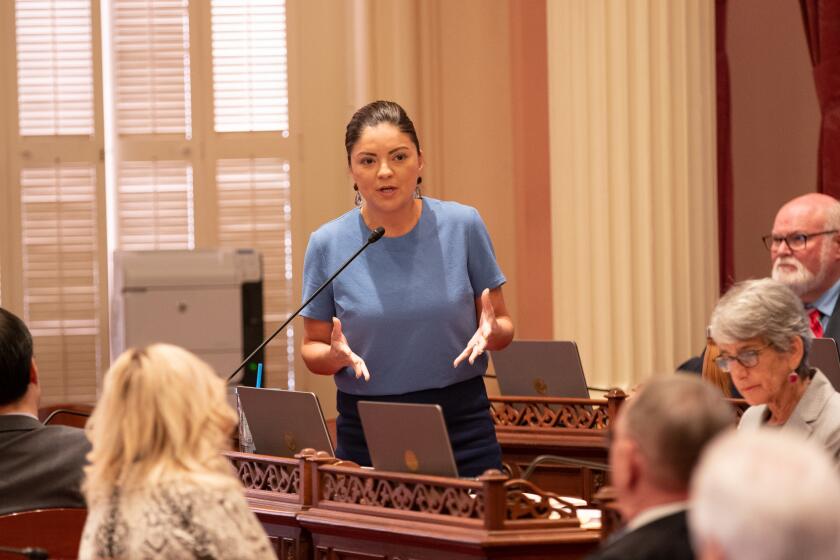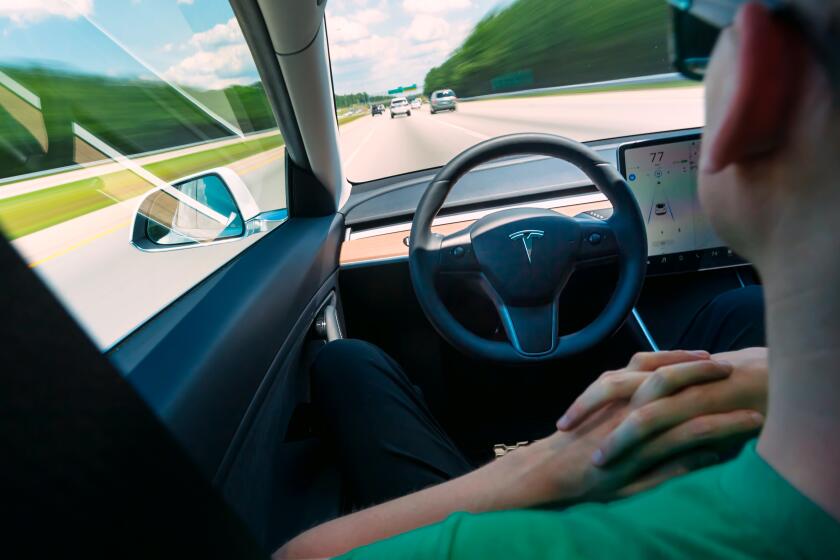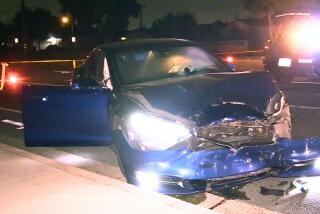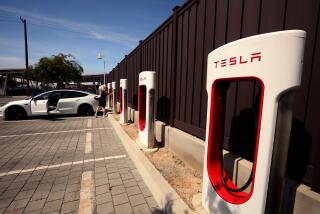Editorial: Slam the brakes on Tesla’s self-driving madness

In recent years, some Tesla owners have had the option to buy a $10,000 software upgrade to test what the company calls its “Full Self-Driving” package, essentially making ordinary drivers on public roads part of a vast experiment of the company’s autonomous vehicle technology. The problem is, unlike a real experiment, this one lacks oversight to track successes and failures, and — most importantly — to ensure public safety.
It’s time for state and federal regulators to step in.
In a spate of recent videos, users of Tesla’s “self-driving” technology have shown that these cars cannot safely drive themselves. They’re crossing double yellow lines and heading toward oncoming traffic, failing to stop for cars crossing the street, and steering toward metal posts and roadside boulders.
“Collisions were avoided only because of swift action by the driver,” state Sen. Lena Gonzalez (D-Long Beach) wrote in a letter to the head of the California Department of Motor Vehicles, as reported recently by The Times’ Russ Mitchell.
Until now, the DMV has taken a hands-off approach to Tesla’s development of self-driving cars. State legislators say it’s time for the agency to be more transparent.
How widespread are the problems? It’s hard to say because Tesla isn’t reporting its data to the DMV, which regulates the testing of autonomous vehicles in the state. Are some of the mishaps due to humans using Tesla’s systems in the wrong way? Who knows. Tesla has not publicized that any special training is required of test drivers.
While Tesla follows the Silicon Valley ethos of “move fast and break things,” dozens of other companies experimenting with self-driving technology on California roads are following a reasonable set of rules. They must have a trained and certified test driver behind the wheel and send the DMV regular reports on crashes as well as incidents in which the human driver had to take over to avoid a crash.
What accounts for the difference? Neither Tesla nor the DMV is saying much. Tesla disbanded its press office and doesn’t take questions from the media. DMV Director Steve Gordon has not spoken publicly about how his agency regulates self-driving cars and has declined numerous interview requests from The Times.
But the answer appears to boil down to the difference between what Tesla is telling its customers and what it’s telling government regulators. While the fine print on Tesla’s website says “Full Self-Driving” is “intended for use with a fully attentive driver who has their hands on the wheel,” the message engrained in the branding sure sounds like a car that drives itself. The message to DMV officials, however, is that the technology is not actually capable of self-driving and, therefore, is subject to less regulation.
Tesla has been selling cars advertised as capable of full-self driving while telling regulators they’ll continue to need human oversight for the foreseeable future.
Even though Tesla CEO Elon Musk routinely brags about his company’s driverless technology — helping fuel his rise to become the world’s second-richest person and now, Time magazine’s “Person of the Year” — Tesla has so far convinced the DMV not to treat its “Full Self-Driving” cars as autonomous vehicles that must follow the same rules other companies obey when testing on California roads. Instead, a DMV spokesperson told The Times that Tesla informed the agency that “Full Self-Driving” cars are in a different category, known as “level 2,” that incorporates more common driver-assistance tools like automatic steering and cruise control but still require attention from a human driver.
California cannot continue letting Tesla have it both ways. If the cars are automated enough to be marketed as “Full Self-Driving,” then they must be required to follow the same testing rules as other autonomous vehicles that roam our roads. If the cars are not automated enough to be regulated as autonomous vehicles, then Tesla should not be allowed to market the technology as “Full Self-Driving.”
“I can call my umbrella a parachute, but that doesn’t make it true. It just makes it more dangerous,” notes Bryant Walker Smith, an expert in autonomous vehicle law at the University of South Carolina.
In the rush to rollout driverless cars, Tesla is playing fast and loose with public safety — and California is playing along.
Under a state law passed nearly a decade ago, the DMV has the power to regulate “Full Self-Driving” Teslas the same way it regulates other companies that are developing autonomous vehicles. This does not necessarily require a change in law, though it’s good to see that lawmakers on the Assembly and Senate transportation committees are asking the DMV for more information and considering potential legislation if it turns out Tesla is operating in a legal gray area.
Gov. Gavin Newsom — a longtime Tesla owner who has known Musk for 20 years and called him “one of the world’s greatest innovators and entrepreneurs” — should lean on DMV Director Gordon to make Tesla play by the same rules as the companies it competes with. (While he’s at it, we hope Newsom will tell Gordon to talk to The Times. Government leaders serve the public and shouldn’t be allowed to hide from the media.)
The federal government has a role to play as well. The National Highway Traffic Safety Administration has stepped up scrutiny of advanced driving technology since President Biden took office. It opened an investigation this summer into Tesla’s “Autopilot” system, a precursor to “Full Self-Driving” that has been involved in 11 crashes, leaving one person dead and 17 people injured. And it announced it will investigate a crash last month in Brea in which a Tesla in “Full Self-Driving” mode took a left turn into the wrong lane. Two U.S. senators have asked the Federal Trade Commission to look at whether Tesla’s “Full Self-Driving” branding amounts to deceptive marketing. These are good first steps but not the kind of robust oversight that will make people confident in this emerging technology.
California can continue being a cradle of innovation while demanding more accountability from the companies that are developing the future of transportation on our roads. The safety of millions of drivers, cyclists and pedestrians demands nothing less.
More to Read
A cure for the common opinion
Get thought-provoking perspectives with our weekly newsletter.
You may occasionally receive promotional content from the Los Angeles Times.













